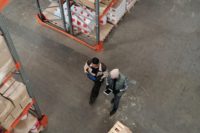Utilize camera technology to increase fall protection safety

“The last thing I remember is being at work conducting a last-minute inspection job that would likely take less than 20 minutes, if I found nothing that needed to be repaired. I remember being in a hurry, because it was near quitting time. I had a ticket to the game and had to leave work on time to meet the guys at the pub for burgers before the game. I placed the extension ladder and did not get anyone to foot it for me. I was going up only eight feet; what could happen? I was near the top of the ladder when I felt it start to slide backwards. The next thing I know, I’m in this hospital bed with my head bandaged and no feeling in my legs.”
High workplace fatalities
The preceding text is hypothetical, but the accident was real. The individual was inspecting the second level corridor of a dormitory under construction, which was scheduled to be concreted. After his inspection, while descending to the ground floor via an extension ladder, he fell with the ladder and landed on the ground. The individual suffered head injuries and was hospitalized; he eventually passed away more than six months after the accident.
Workplace deaths caused by falls from elevated work locations are consistently second only to those caused by motor vehicle accidents. Last year OSHA issued more citations for fall protection violations than for any other category. This was the ninth consecutive year that fall protection topped the citation list. Besides the obvious health and safety consequences for workers, practices cited in these violations can result in company fines totaling hundreds of thousands of dollars; plus, managers can personally face significant fines, multiple year prison terms, and staggering civil penalties. Fines can occur even when there is no fall. Fines result from allowing improper use of ladders; not providing employees with head protection; failure to properly train employees; and failure to protect workers with adequate fall protection gear and systems.
Technology reduces risk
How can the risk of a fall from an elevated location such as a ladder, platform, scaffold, and even rooftop, be reduced? The best way is to keep a worker on the ground as much as possible.
Many of these accidents occur when workers are involved in various maintenance or repair tasks of equipment, structures, or systems that are in elevated locations. The first step of any such operation is to inspect the area that is the focus of the operation. If this location or equipment resides in an elevated location, then the individuals who are conducting the procedure typically use a ladder, scaffold, or elevated platform to perform an initial inspection. In many instances, however, it is this step that can be conducted with the individual safely on the ground by using a remote video inspection system.
A remote video inspection system that is configured with a camera, display, and telescopic pole can increase safety during this initial phase of many operations. This allows the operator to remain on the ground, while the camera is extended on the pole to perform the inspection. Pole cameras are available that extend 10, 20, 30 feet, and higher. The video images of the object or environment can be viewed by the operator on body-worn or hand-held display systems, while safely positioned on the ground.
If no problem is found, then a potentially dangerous operation on a ladder or scaffold is avoided. If a problem is found, then the individual knows in advance what tools or materials are required to remedy the problem. In addition, the operator can be made aware of any unknown hazard that may be present, such as high voltage electrical cables, loose objects, plumbing leaks, etc., before climbing above the ground. This advanced knowledge can not only increase ladder safety, but also reduce time spent on a ladder. Still images and videos can be recorded and transmitted via wired or wireless methods to other members of a repair crew or to management and can be stored for future review. Cameras that offer thermal imaging, built-in illumination, and optical zoom can be used to better see problems and potential hazards.
Drones can also play a role in inspection tasks at elevated heights, especially areas that exceed 40-50 feet. Unfortunately, the use of drones can present other challenges and risks to workers. One problem is the risk of collisions caused by pilot error or weather conditions that can send the drone crashing down and seriously injuring individuals in proximity. In addition, drones may not be equipped with sufficient lighting to allow the inspector to see all the details in areas that are dark. There are also a number of relatively new and frequently changing state and federal regulations that govern the use of commercial drones in the workplace, including FAA registration, operator certification, and drone weight.
Use of remote video inspection systems that utilize telescoping video pole cameras can not only increase worker safety and efficiency, but also reduce use of ladders, scaffolding, safety equipment and training. They can also reduce potentially expensive fall protection violations by keeping workers on the ground.
Looking for a reprint of this article?
From high-res PDFs to custom plaques, order your copy today!








